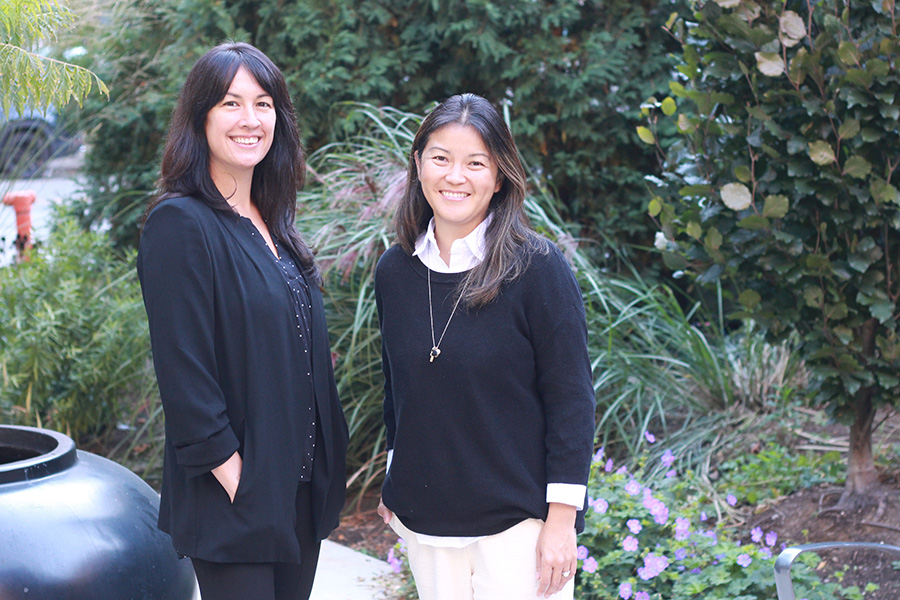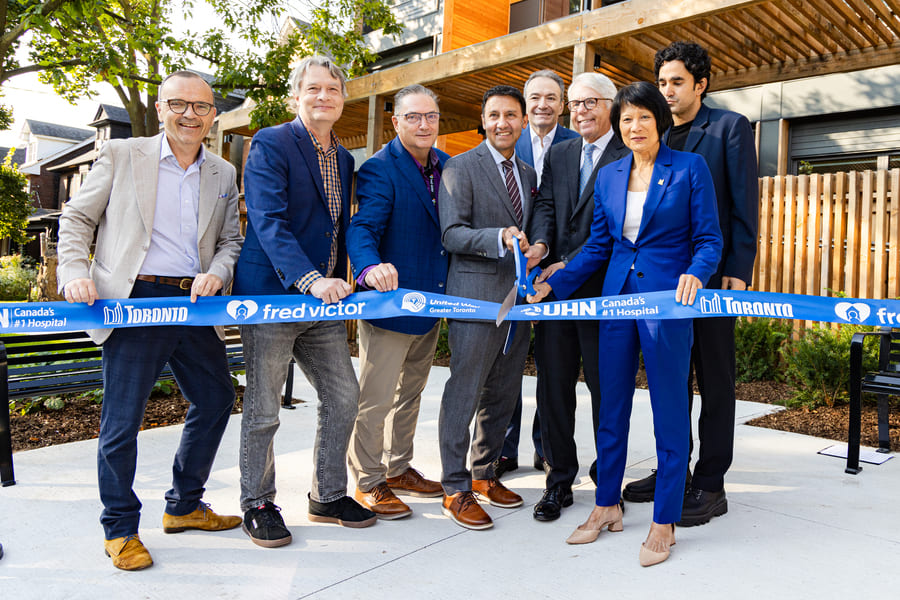Isabel Mannion, (L), and Nenke Jongkind, part of the advisory committee for the NORC Innovation Centre at UHN, are excited to collaborate in this new model to support aging in place. (Photo: UHN)
“I’m not afraid of being dead. I am more afraid of the time before my death.”
The thought expressed by 77-year-old Nenke Jongkind is common among older adults – a fear of not having the appropriate resources to age in place with dignity and choice.
Nenke, who lives with her husband in a co-op building with a majority of residents over the age of 65, is part of the advisory committee for the NORC Innovation Centre (NIC) – an innovation hub being launched at University Health Network (UHN) with the bold mission to design the future of aging in place.
This is a future that will bring a range of services and technology to older adults where they live, and that will empower individuals to co-design these supports, tailoring them to their actual needs.
“I love the notion of creating this NORC model,” says Nenke, who points out that the need for a better system to support the aging population in Canada has been known for a very long time, but with no structured plan to address the issue.
“The old-fashioned idea of institutionalizing all of us is not affordable, not for the government and not for the individual.
“And the idea of for-profit storage of older adults clearly isn’t working,” Nenke adds about the failures in long-term care that were made even more clear during the COVID-19 pandemic.
What is a NORC?
NORC stands for naturally occurring retirement community, an emerging concept to describe buildings that weren’t planned as structures for older adults, and yet they become the major demographic among residents. This trend is stronger in urban centres, where more people older than 65 are moving to condos, co-ops or apartment buildings than ever before.
The idea of bringing programs into NORC buildings isn’t new. Some initiatives have taken place in past decades, especially in New York State and in some communities in Canada – but there isn’t yet an all-encompassing model with all different types of supports needed, from social connection to health care, virtual care and more.

The NIC has identified almost 500 buildings in Toronto alone, where more than 30 per cent of residents are over the age of 65 and with at least 50 residents in this age group. This translates to over 70,000 older adults living in NORCs in the city – that is more than in long-term care and retirement homes combined.
“This means an amazing opportunity to develop a new model to deliver more efficient supports, while honouring where older adults want to stay – at their homes,” says Jen Recknagel, Director of Innovation and Design of the NIC.
“How can we support NORC residents in making their buildings an amazing place to grow old? And it’s not just about health services; it’s about creating a sense of belonging, community, and leveraging aging-in-place design and technology.”
With funding from a generous donor to UHN Foundation, a team that started at UHN OpenLab – a design and innovation shop dedicated to finding creative solutions in health care – came together with UHN Connected Care – a strategy and delivery team focused on scaling and sustaining new models of care – to create the NIC.
The centre will be a complete innovation hub at UHN, leveraging the expertise and capabilities across the health network. It will have operational, policy development, research and design arms.
The NIC will operate early adopter sites and partner with residents, building owners and community service providers to create a 21st century Canadian-made NORC model. The selected sites will be diverse, including co-op buildings, social housing, condos, highrises, in downtown and suburbs, so that the model can be tested and adjusted to serve a wide range of communities.
The learnings will be researched, recorded and shared with other jurisdictions so this model can be improved and expanded across Canada and beyond. Teams at NIC will also show the benefits for the system as a whole, collecting and organizing data to support policy implementation and sustainable funding models.
A first example of this work is the policy paper recently published in partnership with the National Institute of Ageing.
“The NIC plays an important role in keeping people healthy and provides integrated health and social care where and when they need it,” says Melissa Chang, Director of Operations and Sustainability of the NIC. “This means we need to build connections to address loneliness and social isolation, as well as look at social determinants of health and other needs.
“And from a system perspective, it is way more efficient to take health care to where older adults are. It improves their quality of life, and decreases the need for hospitalization and institutionalization.”
The ideal place to live
Similar to Nenke, Isabel Mannion has joined the NIC advisory committee. She is 88 and lives in a condo building in Toronto that older adults naturally gravitated to.
In Isabel’s building, there is a resident committee that organizes social activities such as a film club, a book club, group exercise, a zoom chat group and card games. As much as these provide valuable social connections, she thinks they still fall short in addressing other needs she and her neighbours have.
After a career as a nurse and administrator at a variety of health care facilities, including a multi-year experience as surveyor inspecting nursing homes coast to coast, Isabel knows there will be challenges around proposing and implementing a comprehensive NORC model, but she is excited to be part of it.
“I care very much about the future of our country as we are aging, and we can’t continue down this path,” Isabel says. “We must be proactive in finding a model that provides the highest quality of life for older adults in a cost-effective manner.”
In the early adopter sites where NIC will co-design the new model, they will hire an “animator” – someone who will work with residents to bring in what they need to remain independent – from health talks, flu clinics, digital literacy classes, and health care navigation support, to creating more opportunities for meaningful social engagement and fun.
“There are already great services and technology available to support older adults in the community,” says Jen Recknagel. “Our goal is to build on what already exists, and empower residents to choose and improve these resources to fit their needs.”


